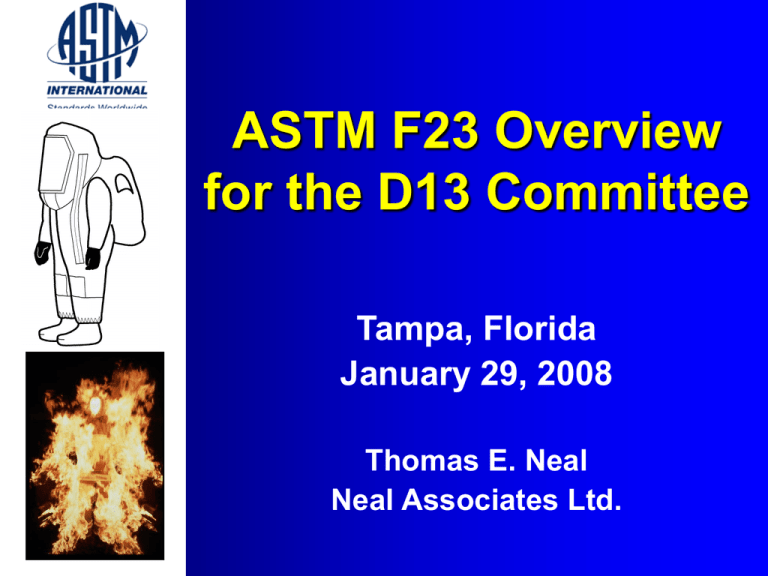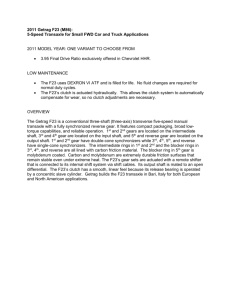77
advertisement

ASTM F23 Overview for the D13 Committee Tampa, Florida January 29, 2008 Thomas E. Neal Neal Associates Ltd. F23 Committee Overview Topics • History • Expanded Scope • Structure and Process • Committee Liaisons • Subcommittees—Key Standards and New Initiatives • Interface with other organizations • Direction for new standards development F23 History • 1977—Need identified for Standards to protect workers from occupational hazards • 1978—First meeting of F23 at ASTM HQ • 1983—F739 test method on chemical permeation • 1985—F955 test method on molten metal splash • 50 standards addressing six categories of occupational hazards • Membership grew from 50 to ~240 over 30 years F23 Scope This Committee will develop standard specifications, test methods, practices, guides, terminology, and classifications for protective clothing and related personal protective equipment (PPE) designed and constructed to protect the user from potential occupational hazards and/or provide a barrier to prevent the user from being a source of contamination. This Committee will coordinate its efforts with other ASTM Committees and outside organizations having mutual interests. F23 Committee on Personal Protective Clothing and Equipment • Expanded Scope in 2006 to include personal protective equipment • Six Subcommittees for specific hazards • Standard administrative Subcommittees including ISO TAG for PPE • Important interfaces with other ASTM committees and external organizations • Plans to add new subcommittee and liaison committee to meet emerging needs ASTM F23 Organization F23 Committee Administrative Subcommittees F23.20 Subcommittee Physical Hazards F23.60 Subcommittee Human Factors F23.30 Subcommittee Chemical Hazards F23.70 Subcommittee Radiological Hazards F23.40 Subcommittee Biological Hazards F23.80 Subcommittee Thermal Hazards F23 Administrative Subcommittees • F23.90 Executive Subcommittee – Nominating Committee – Awards Committee – Plan to create new standing committee to manage liaison with other standards bodies and end users • F23.91 Terminology Subcommittee – Vince Diaz, Chair • F23.92 .93 .94 Publicity, Education & Symposia • F23.95 Planning Subcommittee – Angie Shepherd, Chair and Vice-Chair of F23 • F23.96 ISO TAG – Jeff Stull, Chair PPE Standards Process Conduct Hazard Assessment Prepare PPE Selection Guidance Establish PPE Criteria and Specification Verify PPE Conformity to Standard • Users rely on standard so they don’t have to know all the details about product performance • Each part of the process is important to ensure that the correct product is selected and that it will perform as expected Principal ASTM Committee Liaisons D11 Rubber E12 Visibility F23 Protective Clothing and Equipment D13 Textiles D20 Plastic s E54 Homelan d Security F18 Electrical Workers Key F23 External Liaisons • Synergistic relationship in developing test methods for specifications • Joint standards development and promotion through MOU • Input to worker protection practices in key industry (e.g. industrial hygiene) • Representative for United States in PPE related international standards F23.20 Physical Hazards Libby Parrish, Chair • Key Standards – – – – – F1342 puncture resistance F1670 cut resistance F1414 chainsaw resistance F1818 chainsaw foot protection F1897 chainsaw leg protection • New Initiatives – Needlestick puncture resistance F23.30 Chemical Hazards Jim Zeigler, Chair • Key Standards – F739 (permeation) – F903 (penetration) – F1001 Chemical Test Battery – F1052 (inflation test) – F1359 (liquid integrity) – F2588 (MIST) • New Initiatives – Air-fed ensembles – New permeation procedure – Chemotherapy gowns F23.40 Biological Hazards David Johnson, Chair • Key Standards – – – – F1670 blood penetration F1671 viral penetration F1862 mask blood test F2100 medical face masks – F2407 surgical gowns • New Initiatives – Mask decontamination – Antimicrobial test F23.60 Human Factors Shawn Deaton, Chair • Key Standards – – – – – – – F1154 Form/function F1291 Manikin clo test F1868 Total heat loss F2010 Glove dexterity F2300 Cooling systems F2370 Sweating manikin F2668 Physiological practice • New Initiatives – Material wicking (GATS) – Clothing insulation ratings F23.70 Radiological Hazards Gary Glenn, Chair • Key Standards – F2547 X-ray attenuation • New Initiatives – Fluoroscopic to inspect Xray vests – Apparel for nuclear power plant workers – Attenuation of high energy radiation – Radiological emergency responder PPE F23.80 Thermal Hazards David Loftin, Chair • Key Standards – F955 (molten metal splash) – F1060 (conductive heat) – F1930 (thermal manikin) – F1939 (radiant performance) • New Initiatives – – – – New TPP procedures Stored energy test Hot liquid test Heat resistance D6413 Test Method Vertical Flammability F1930 Simulated Flash Fire Test Method F1930 Simulated Flash Fire Test Method Key F23 Initiatives • Foster more end user involvement in standards process • Work towards more end product specifications – Example: air-fed protective ensembles • Address gaps in personnel protection for applications or hazards not addressed – Agricultural protective clothing – Radiological protective equipment • Work on protective equipment standards in line with expanded scope • Establish new subcommittee on Certification and Interoperability Questions & Comments
